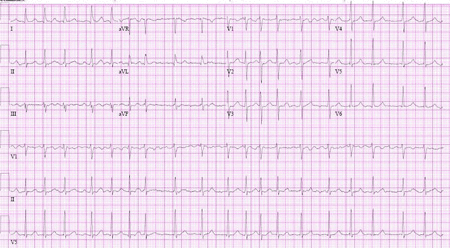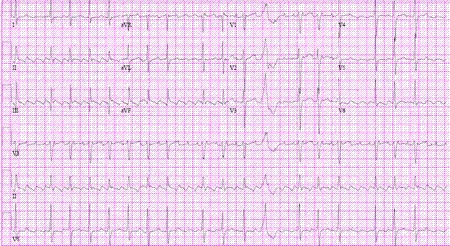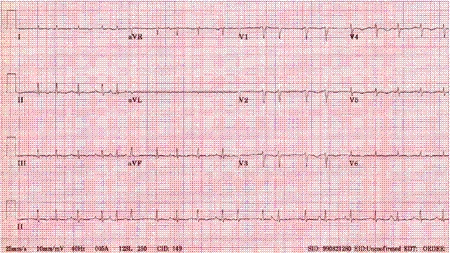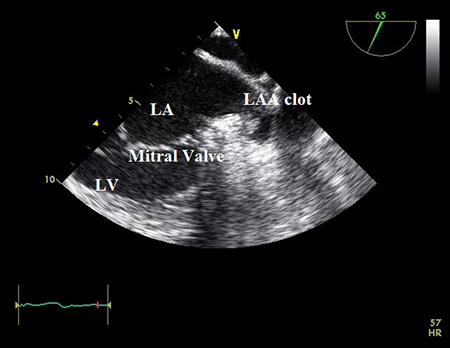Approach
New-onset AF can present with rapid palpitations, fluttering in the chest, dizziness, or shortness of breath. Some patients may also present with stroke and embolic events. The onset of the first episode, its duration, and precipitating factors should be established. The presence of symptoms at the first presentation does not affect the longer-term prognosis, but does increase the likelihood of detecting AF, and making the correct diagnosis.[74]
History and examination
The majority of patients present with symptoms related to the arrhythmia, most of which occur as a result of a rapid ventricular rate. Typical symptoms include palpitations, a sense of the heart racing, dizziness and shortness of breath. Some patients may present with focal neurologic deficits such as hemiplegia or dysphasia due to a stroke.
The pulse should be assessed. An irregularly irregular pulse, both in the rhythm and volume, is characteristic. Signs of the underlying cause of AF, such as elevated neck veins (jugular venous pressure) and pulmonary crepitations in heart failure or tremor, sweating, and goiter in hyperthyroidism, should be looked for.
ECG
An ECG should be the first test requested. Absent P waves that have been replaced by irregular fibrillatory waves, and irregularly irregular QRS complexes will confirm the diagnosis of AF.
[Figure caption and citation for the preceding image starts]: Atrial fibrillationFrom the collections of Arti N. Shah and Bharat K. Kantharia [Citation ends].
In contrast, P waves that have been replaced by a saw-tooth appearance in the inferior limb leads, and QRS complexes that are regularly (typically 2:1, 3:1, 4:1 P to QRS ratio) irregular are characteristic of atrial flutter. Abnormal and variable morphology P waves can occur in atrial tachycardia.[Figure caption and citation for the preceding image starts]: Atrial flutterFrom the collections of Arti N. Shah and Bharat K. Kantharia [Citation ends]. [Figure caption and citation for the preceding image starts]: Multifocal atrial tachycardiaFrom the collections of Arti N. Shah and Bharat K. Kantharia [Citation ends].
[Figure caption and citation for the preceding image starts]: Multifocal atrial tachycardiaFrom the collections of Arti N. Shah and Bharat K. Kantharia [Citation ends].
The ECG may also show evidence of possible underlying causes, such as left ventricular hypertrophy or previous myocardial infarction.
Patients with concomitant severe atrioventricular conduction block (inherent or drug-induced [e.g., digoxin toxicity]) may have bradycardia and regular ventricular escape rhythm resulting in regular QRS complexes. In patients with pacemakers, ECG may exhibit regular ventricular paced complexes. In these patients, the atrial rhythm will still show irregular fibrillatory waves from AF.
Mobile health technologies, including smart devices, are a popular research area for AF detection.[75][76] There are currently >100,000 mobile health apps and ≥400 wearable activity monitors available, and while many have been shown to be highly sensitive and specific at detecting AF, most are not clinically validated and caution is advised for clinical use.[2][77][78] The WATCH AF and Apple Heart studies compared smartwatch-based technologies and algorithms with diagnosis of AF by cardiologists; the results suggest that use of commercially-available devices may have some accuracy in detecting AF and are potentially feasible as complementary tools for screening.[11][79][80] If AF is detected by mobile or wearable devices, the diagnosis should always be confirmed with single-lead or 12-lead ECG analyzed by a physician with expertise in ECG rhythm interpretation.[2][79][80]
How to record an ECG. Demonstrates placement of chest and limb electrodes.
Investigation for causal factors
Blood biochemistry should be checked for electrolyte abnormalities. Cardiac biomarkers should be checked if chest pain is a feature. Thyroid function testing should be part of the initial assessment, particularly in older people, as classic signs of thyrotoxicosis may not be obvious.[52][81]
High-sensitivity (hs) troponins may be elevated in patients presenting with AF. The hs troponin level is independently associated with a raised risk of stroke, cardiac death, and major bleeding and improves risk stratification beyond the CHA₂DS₂-VASc score.[82][83]
Liver function tests (LFTs) are useful to determine presence of a multisystem disorder affecting the liver. Furthermore, LFTs are useful to choose appropriate antiarrhythmic agents and to monitor antiarrhythmic drug therapy. For example, amiodarone is contraindicated in the presence of liver dysfunction; and amiodarone treatment should be discontinued when LFTs show abnormalities.
A chest x-ray (CXR) should be performed to look for evidence of structural heart disease, such as enlargement of the cardiac chambers or valvular calcification, and signs of heart failure. The CXR may also suggest a precipitating cause of AF, such as pneumonia.
Following the initial assessment, patients should undergo echocardiography to evaluate cardiac chamber size and left ventricular function. This may also reveal an underlying cause such as valvular disease.[84] A transesophageal echocardiogram is essential in patients before cardioversion (unless they are already anticoagulated) to rule out left atrial clots.[Figure caption and citation for the preceding image starts]: Transesophageal echocardiogram showing left atrial appendage clot. LA=left atrium; LAA=left atrial appendage; LV=left ventricleFrom the collection of Dr Bharat Kantharia [Citation ends].
Electrophysiologic studies may be required to identify arrhythmias such as Wolff-Parkinson-White syndrome, atrial flutter, or paroxysmal supraventricular tachycardia.
Exercise echocardiography and the exercise nuclear imaging stress test are both useful to identify structural abnormalities of the heart and assess for coronary artery disease. A stress test is useful to assess adequate rate control when a rate control strategy is used. The exercise stress test also helps to determine whether there is a “use dependence” pro-arrhythmic effect (i.e., when channel-blocking agents have greater effect at faster heart rates, and thus may be proarrhythmic at faster rate) of class Ic antiarrhythmic agents such as flecainide and propafenone.[85] However, do not use these tests or coronary CT angiography routinely in the initial diagnosis of AF if there are no symptoms or signs of cardiovascular disease.[86]
A treadmill exercise stress test may be useful for risk stratification for risk of sudden cardiac death in patients with Wolff-Parkinson-White syndrome. The sudden loss of pre-excitation delta waves at a faster heart rate during exercise stress testing indicates that the antegrade conduction property of the accessory bypass tract is weaker, and the risk of sudden cardiac death from AF is therefore lower.
Use of this content is subject to our disclaimer
